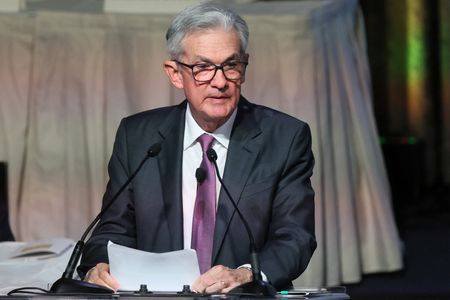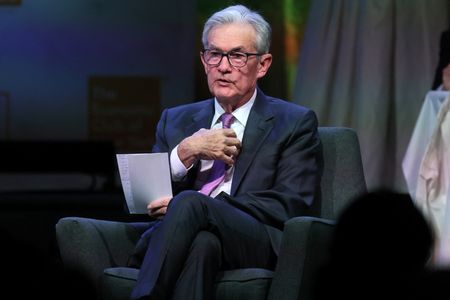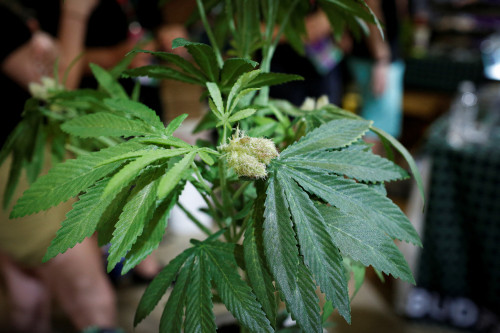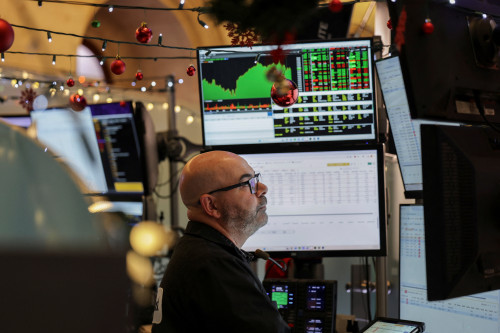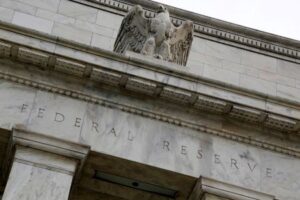By Howard Schneider and Michael S. Derby
NEW YORK (Reuters) -The U.S. economy’s strength and continued tight labor markets could still warrant tighter financial conditions, Fed Chair Jerome Powell said on Thursday, though rising market interest rates could make action by the central bank itself less necessary.
Appearing to align himself with Fed colleagues who have recently said the bond market is now doing some of their work for them, Powell in remarks to the Economic Club of New York agreed “in principle” that the rise in yields was helping to further tighten financial conditions and “at the margin” might mean more rate hikes are not as needed.
It was not an explicit endorsement of that view, but financial markets seemed to read it as such and as Powell spoke they leaned further into bets that the Fed is done raising rates. Futures that settle to the Fed’s policy rate are pricing less than a one-in-three chance of another rate hike this year, down from about 40% before he spoke.
In raising the Fed’s benchmark interest rate “the whole idea…is to affect financial conditions,” Powell said. Bond markets “are producing tighter financial conditions right now,” and seemed to be moving for a variety of reasons, such as an upgraded view of the U.S. economy’s strength, independent of any expectations about the Fed.
It is an important distinction, Powell noted. If bond investors were raising long-term bond yields only because they thought the Fed was about to raise its own short-term policy rate, the central bank would have to follow through – or long-term rates would fall.
This appears to be a different dynamic, and one that Powell and several of his colleagues have suggested in recent days could begin substituting a market-driven tightening of credit for changes in the Fed’s short-term federal funds rate.
A NARROW LINE
Powell walked a narrow line in his remarks, leaving open the possible need for more rate hikes because the economy had proved stronger than expected, but also noting emerging risks and a need to move with care.
“We are attentive to recent data showing the resilience of economic growth and demand for labor,” Powell said in prepared remarks that were delayed briefly by climate protesters. “Additional evidence of persistently above-trend growth, or that tightness in the labor market is no longer easing, could put further progress on inflation at risk and could warrant further tightening of monetary policy.”
Since the Fed began raising interest rates in March of 2022 the unemployment rate has varied little from the current 3.8%, below the level most Fed officials feel is noninflationary, and overall economic growth has generally remained above the 1.8% annual growth rate Fed officials see as the economy’s underlying potential.
The Fed, Powell said, is “proceeding carefully” in evaluating the need for any further rate increases, a remark that left intact expectations that the Fed will leave its benchmark policy rate steady at the current 5.25% to 5.5% range at the upcoming Oct. 31-Nov. 1 meeting.
There is evidence the labor market is cooling, Powell said, with some important measures approaching levels seen even before the pandemic, and inflation has also dropped steadily from the highs of last year.
Powell also noted a number of fresh “uncertainties and risks” that need to be accounted for as the Fed tries to balance the threat of allowing inflation to rekindle against the threat of leaning on the economy more than is necessary.
Those include new geopolitical risks to the economy from the “horrifying” attack on Israel by the Palestinian militant Hamas group, Powell said.
“Our institutional role at the Federal Reserve is to monitor these developments for their economic implications, which remain highly uncertain,” Powell said. “Speaking for myself, I found the attack on Israel horrifying, as is the prospect for more loss of innocent lives.”
But the immediate concern for the Fed has been how to make sense of changes in the bond market that have seen long-term bond yields rise roughly a percentage point since the Fed’s last quarter point rate increase in July – a move that Powell said helped to “significantly” tighten credit conditions.
To substitute for Fed action, however, the changes will have to prove persistent at a time when Powell said the Fed still is not yet fully convinced it was won its battle with inflation.
A BUMPY PATH
“Inflation is still too high, and a few months of good data are only the beginning of what it will take to build confidence that inflation is moving down sustainably toward our goal,” Powell said, citing the progress made since inflation peaked last year but also noting that one of the Fed’s main measures of inflation remained at 3.7% through September, nearly twice the central bank’s target.
“We cannot yet know how long these lower readings will persist, or where inflation will settle over coming quarters,” Powell said. “The path is likely to be bumpy and take some time…My colleagues and I are united in our commitment to bringing inflation down sustainably to 2%.”
The weeks since the Fed’s September meeting have been unusually turbulent, with worries about regional war in the Middle East rising and bond markets driving market interest rates higher.
Data since the Fed’s last meeting also has shown U.S. job growth reaccelerating unexpectedly, retail sales defying predictions of a slowdown and varying measures of prices offering inconsistent signals about whether inflation is on track to return to the Fed’s 2% target in a timely manner.
(Reporting by Howard Schneider and Michael S. Derby; Additional reporting by Dan Burns and Ann Saphir; Editing by Chizu Nomiyama and Andrea Ricci)

